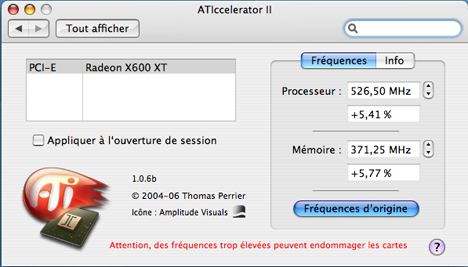Intel Graphics Media Accelerator X3100This is an Intel video adapter Features
|
- Accelerator Ii On The Fly Overclocking For Macbook Air
- Accelerator Ii On The Fly Overclocking For Mac Download
The Intel opensource videodriver is maintained by Intel at intellinuxgraphics.org.Intel releases a new driver once per quarter. The latest stable release is 2.10.
Kernel mode setting (KMS)
KMS (Kernel Mode Setting) as the name suggests moves some video setup functions to the kernel. This should have the following benefits over legacy mode setting
- increased stability, because it removes the current contention between the X server and the kernel
- ability to show kernel dump screens even when the X server was running
- rapid mode switching
- in theory should not allow the X video driver to hang the system
- early graphical boot display with seamless login
- should in the future allow for the X server to run without root privileges
Note that KMS does not eliminate the need for the Intel Xorg driver, it just frees that driver from the hardware setup functions.
Download EVGA Precision 4.2.1 - it you to fine tune your GeForce graphics card for the maximum performance possible, with Core/Shader/Memory clock tuning, real time monitoring support including in. Description: This article contains some of the most frequently asked questions about Overclocking from Summer 2019. Q: What is overclocking? A: Overclocking is the act of increasing the clock speeds of components to obtain an increase in performance. This is often accompanied by an increase in voltage.
Status

Right now KMS is still in heavy development, and officially requires at least kernel 2.6.29 with version 2.7 of the Intel driver. But in reality you should really be running at least the 2.6.30.5 kernel and version 2.8 of the Intel driver.
Configuration
In this mode, ideally you do not configure any settings through xorg.conf but by using xrandr, or a graphical front-end to RandR such as gnome-display-settings.
Disabling KMS
If KMS causes you problems, you can disable it and return to user mode setting (UMS) by booting with the nomodeset kernel boot option. Note that this is no longer an option starting with version 2.10 of the Intel Xorg driver as UMS support has been dropped.
User mode setting (UMS)
Linux X.Org driver
Supported by Xorg [1]. The driver supports hardware accelerated 3D via the Direct Rendering Infrastructure (DRI), but only in depths 16 and 24.
Version 2.1.1 of the driver fixes a TV output problem. Use xrandr to view the enabled screens in X.
Linux Intel driver

There is a Graphics driver for the Mobile Intel 965 Express Chipset Family at Intels Support Site. This driver is just a snapshot of the Xorg/XFree86 driver.
ThinkPad LCD
Display on the internal LCD works as long as you set the monitor settings correct.
External VGA port
Works. Dualhead is supported.

Accelerator Ii On The Fly Overclocking For Macbook Air
Dynamic configuration: XRandR
Since xorg>=7.3 and 2.2 intel driver, XRandR 1.2 works for adding/removing monitors on the fly. The only hard-coded thing is virtual desktop size in xorg.conf, which must always encompass all monitors and may not be changed at X runtime.
For the rest, see man xrandr, I have a script to turn on dual-head at work (self-explanatory):
To disable external (VGA) screen,
Static configuration via /etc/X11/xorg.conf
There are two options for running the external VGA port - either as a copy of the LCD (clone) or as a separate workspace. Here is an example for the separate workspace mode for xorg.conf for the X60s:
Or try:
Here is the relevant text for running the VGA port as a true clone (so even things like Xine video playback appears on both screens) of the internal LCD display:
SVideo port
Does not work with Ubuntu 7.10.See https://bugs.launchpad.net/ubuntu/+bug/178910
DVI port
The DVI port on a ThinkPad Advanced Mini Dock is supported and works with dual-head. Follow the notes for the VGA output above, but replace 'VGA' with 'TMDS-1'.
Accelerator Ii On The Fly Overclocking For Mac Download
There is almost certainly a way to make the xrandr commands run automatically when you dock or undock. I'll figure it out once I install Hardy (I just tried it with the beta Live CD).
Suspend behaviour
- Required kernel parameters for suspend to ram: none
Nevertheless, you may get a blank screen on resume (for example on T61 with Ubuntu Gutsy). See launchpad bug for details.
Compiz won't work with external Monitor
As told here Link in Ubuntu 8.10 there is a bug in the MESA driver, that prevents you from using resolutions bigger then 2048x2048. If you connect a second monitor bigger then 1024 compiz (and DRI) won't work.
You can check your system with the command
The number (here 2048) is the resolution limit.
You have to compile the intel x-server (only on ubuntu 8.04) and the mesa driver. here is the whole procedure described.
If you're using Ubuntu 8.10 you can also use the precompiled deb file here
ThinkPads this chip may be found in

- X61, X61s, X61 Tablet
- R61, R61i